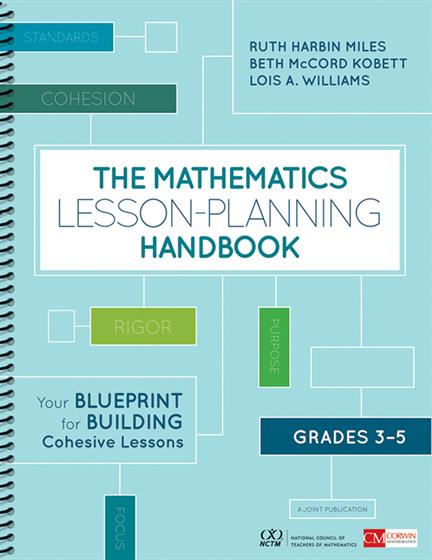Hands-on, Practical Guidance for Educators
From math,
literacy, equity, multilingual learners, and SEL, to assessment, school counseling,
and education leadership, our books are research-based and authored by experts
on topics most relevant to what educators are facing today.

The Mathematics Lesson-Planning Handbook, Grades 3-5
NCTM Stock Number is 15701.
This reference offers practical guidance for when and how to pull together mathematics routines, resources, and teaching techniques into a coherent set of lesson plans.
- Grade Level: 3-5
- ISBN: 9781506387864
- Published By: Corwin
- Series: Corwin Mathematics Series
- Year: 2018
- Page Count: 248
- Publication date: July 31, 2018
Review Copies
Description
“This book brings together the best of Visible Learning and the teaching of mathematics. The chapters on learning intentions, success criteria, misconceptions, formative evaluation, and knowing thy impact are stunning. Rich in exemplars, grounded in research about practice, and with the right balance about the surface and deep learning in math, it's a great go-to book for all who teach mathematics.”
—John Hattie, Laureate Professor, Deputy Dean of MGSE, Director of the Melbourne Education Research Institute, Melbourne Graduate School of Education
YOU are the architect in the mathematics classroom.
When it comes to mathematics lessons, do you sometimes feel overly beholden to the required texts from which you teach? Do you wish you could break the mold, but feel like you get conflicting guidance on the "right” things to do? How often do you find yourself in the last-minute online scramble for a great task activity that will capture your students' interest and align to your state standards?
In The Mathematics Lesson-Planning Handbook, Grades 3–5: Your Blueprint for Building Cohesive Lessons, you’ll learn the streamlined decision-making processes that will help you plan the focused, research-based, standards-aligned lessons your students need. This daily reference offers practical guidance for when and how to pull together mathematics routines, resources, and effective teaching techniques into a coherent and manageable set of lesson plans. This resource will
- Lead teachers through a process of lesson planning based on various learning objectives
- Set the stage for lesson planning using relatable vignettes
- Offer sample lesson plans for Grades 3–5
- Create opportunities to reflect on each component of a mathematics lesson
- Suggest next steps for building a unit from the lessons
- Provide teachers the space and tools to create their own lesson plans going forward
Based on years of classroom experience from seasoned mathematics educators, this book brings together the just-in-time resources and practical advice you need to make lesson planning simple, practical, and doable. From laying a solid foundation to choosing the right materials, you’ll feel confident structuring lessons that lead to high student achievement.
Key features
Includes:
- Vignettes and concrete examples in every chapter
- Sample lessons for each grade level in grades 3-5
- Guidance for planning at the unit and lesson level
- Stop and reflect sections
- Prompts and room for writing to build your own lesson plans
- Companion website contains downloadable versions of all templates, tasks, and sample lessons
Author(s)

Ruth Harbin Miles
Ruth Harbin Miles coaches rural, suburban, and inner-city school mathematics teachers. Her professional experiences include coordinating the K-12 Mathematics Teaching and Learning Program for the Olathe, Kansas, Public Schools for more than 25 years; teaching mathematics methods courses at Virginia’s Mary Baldwin College; and serving on the Board of Directors for the National Council of Teachers of Mathematics, the National Council of Supervisors of Mathematic, and both the Virginia Council of Teachers of Mathematics and the Kansas Association of Teachers of Mathematics. Ruth is a co-author of five Corwin books including A Guide to Mathematics Coaching, A Guide to Mathematics Leadership, Visible Thinking in the K-8 Mathematics Classroom, The Common Core Mathematics Standards, and Realizing Rigor in the Mathematics Classroom. As co-owner of Happy Mountain Learning, Ruth specializes in developing teachers’ content knowledge and strategies for engaging students to achieve high standards in mathematics.

Beth McCord Kobett
Beth McCord Kobett serves as Professor and Dean in the School of Education at Stevenson University, where she works closely with early childhood, elementary, and middle school preservice teachers. She brings experience as a classroom teacher, mathematics specialist, and university supervisor. Beth served on the NCTM Board and served as president of Association of Maryland Mathematics Teacher Educators. Beth has authored ten mathematics education books and supports professional learning efforts nationwide. She has been honored with awards such as the MCTM Mathematics Educator of the Year and Stevenson’s Rose Dawson Award for Excellence in Teaching. Deeply committed to her students, she strives to create a supportive, strengths-based learning environment that fosters curiosity, collaboration, and meaningful growth.

Lois A. Williams
After teaching mathematics in grades K-8 for 20 years, Lois served as the middle school mathematics specialist for the Virginia Department of Education. Here she worked on curriculum and teacher professional learning. She served the Virginia Council of Teachers of Mathematics and was a board member for the local Jefferson Council of Teachers of Mathematics. After receiving her doctorate in curriculum and instruction at The University of Virginia, she began serving as adjunct faculty to Mary Baldwin College and is in her 15th year working with pre-service teachers. Currently Lois is an International Fellow with the Charles A. Dana Center working with classroom teachers in the Department of Defense Schools helping them implement their College and Career Readiness Standards. Among her recognitions are a Fulbright Teacher Exchange and Virginia Middle School Mathematics Teacher of the Year.
Table of Contents
Book at a Glance
Praise Page
Acknowledgements
Publisher's Acknowledgements
Letter to 3-5 Teachers
Letter to Elementary Principals
Letter to Mathematics Coaches
Letter to Preservice College and University Instructors
How to Use This Book
Part I: You Are the Architect of Your Classroom
Chapter 1: Surveying Your Site: Knowing Your Students
Why Is It So Important to Know Your Students?
What Do Access and Equity Really Mean?
How Do Identity and Agency Influence Lesson Planning?
What Is Prior Knowledge in Mathematics?
What Do Culturally and Linguistically Diverse Students Need?
What Do Students Living in Poverty Need?
What Are Learning Needs?
What Are the Common Themes?
Chapter 2: Your 3-5 Blueprint: Planning Mathematics Lessons for Coherence, Rigor, and Purpose
What is Coherence?
What is Rigor?
What Is the Purpose of a Lesson?
How Can You Ensure that You Plan Lessons for Coherence, Rigor, and Purpose?
Lesson-Planning Template
Part II: Drafting Your 3-5 Blueprint
Chapter 3: Laying Your Foundation: It Starts with Big Ideas, Essential Questions, and Standards
What Are State Standards for Mathematics?
What Are Essential Questions?
What Are Process Standards?
Building Unit Coherence
Third Grade Snapshot: Big Ideas, Essential Questions, and Standards
Fourth Grade Snapshot: Big Ideas, Essential Questions, and Standards
Fifth Grade Snapshot: Big Ideas, Essential Questions, and Standards
Under Construction
Chapter 4: Reinforcing Your Plan: Learning Intentions and Success Criteria
What Are Learning Intentions?
What Are Mathematics Learning Intentions?
What Are Language and Social Learning Intentions?
How Do You Communicate Learning Intentions with Students?
What Are Success Criteria?
How Do Learning Intentions Connect to the Success Criteria?
When Should Learning Intentions and Success Criteria Be Shared with Students?
Building Unit Coherence
Third Grade Snapshot: Learning Intentions and Success Criteria
Fourth Grade Snapshot: Learning Intentions and Success Criteria Decision-Making Snapshot
Fifth Grade Snapshot: Learning Intentions and Success Criteria
Under Construction
Chapter 5: Deciding on Purpose: Why Are You Building This Lesson?
What Is the Role of a Conceptual Understanding Lesson?
What Is Procedural Fluency, and How Does It Build from a Conceptual Understanding Lesson?
How Do You Know if You Need a Conceptual Understanding or Procedural Fluency Lesson?
How Do You Create a Transfer Lesson?
Building Unit Coherence
Third Grade Snapshot: Lesson Purpose
Fourth Grade Snapshot: Lesson Purpose
Fifth Grade Snapshot: Lesson Purpose
Under Construction
Chapter 6: Choosing Tasks: The Heart of a Lesson
Why Are Tasks Important?
What Is a Worthwhile Task?
How Do You Adapt Tasks?
What Are Some Sources for Worthwhile Tasks?
Building Unit Coherence
Third Grade Snapshot: Task Selection
Fourth Grade Snapshot: Task Selection
Fifth Grade Snapshot: Task Selection
Under Construction
Chapter 7: Choosing Materials: Representations, Manipulatives, and Other Resources.
What Is the Role of Representations in Mathematics Lessons?
What Is a Manipulative?
How Are Manipulatives Used?
What Are Other Resources?
Building Unit Coherence
Third Grade Snapshot: Material Selection
Fourth Grade Snapshot: Material Selection
Fifth Grade Snapshot: Material Selection
Under Construction
Chapter 8: Cementing the Cracks: Anticipating Student Thinking
What Are Misconceptions, and Where Do They Come From?
How Can You Plan to Minimize Misconceptions?
Building Unit Coherence
Third Grade Snapshot: Student Thinking
Fourth Grade Snapshot: Student Thinking
Fifth Grade Snapshot: Student Thinking
Under Construction
Chapter 9: Framing the Lesson: Formats
What Are Some Different Lesson Formats?
Building Unit Coherence
Third Grade Snapshot: Lesson Format
Fourth Grade Snapshot: Lesson Format
Fifth Grade Snapshot: Lesson Format
Under Construction
Chapter 10: Evaluating Impact: Formative Assessment
What Is Formative Assessment?
What Are Specific Formative Assessment Techniques?
Building Unit Coherence
Third Grade Snapshot: Formative Assessment
Fourth Grade Snapshot: Formative Assessment
Fifth Grade Snapshot: Formative Assessment
Under Construction
Part III: Pulling All the Pieces Together
Chapter 11: Planning to Launch the Lesson
What Is a Lesson Launch?
How Can You Launch a Problem-Solving Lesson?
What Kinds of Lesson Launches Focus on Mathematics Concepts?
What Are Number Routine Lesson Launches?
What Do You Anticipate Students Will Do?
Building Unit Coherence
Third Grade Snapshot: Launch the Lesson
Fourth Grade Snapshot: Launch the Lesson
Fifth Grade Snapshot: Launch the Lesson
Under Construction
Chapter 12: Planning to Facilitate the Lesson
What Is Mathematical Communication?
How Do You Facilitate Meaningful Mathematical Discourse?
How Do You Plan for and Pose Purposeful Questions?
How Do You Facilitate Productive Struggle?
How Do You Make Sure You Engage Students in the Process Standards as You Facilitate the Lesson
Building Unit Coherence
Third Grade Snapshot: Facilitate the Lesson
Fourth Grade Snapshot: Facilitate the Lesson
Fifth Grade Snapshot: Facilitate the Lesson
Snapshot
Under Construction
Chapter 13: Planning to Close the Lesson
Why Do You Need Closure in a Lesson?
What Are Some Different Closure Activities?
Building Unit Coherence
Third Grade Snapshot: Close the Lesson
Fourth Grade Snapshot: Close the Lesson
Fifth Grade Snapshot: Close the Lesson
Under Construction
Chapter 14: Surveying Your Results: Lesson Reflection
Why Is It Important to Reflect upon Lessons?
What Kind of Reflection Cycle Supports Teacher Growth?
Epilogue
Appendix A: Lesson-Planning Template
Appendix B: Complete Lessons for Third, Fourth, and Fifth Grade
Appendix C: Further Reading/Resources
Appendix D: Glossary
References
About the Authors
Reviews
learning intentions, success criteria, misconceptions, formative evaluation, and knowing thy impact are
stunning. Rich in exemplars, grounded in research about practice, and with the right balance about the
surface and deep learning in math, it’s a great go-to book for all who teach mathematics.”
“This book brings together the best of Visible Learning and the teaching of mathematics. The chapters onJohn Hattie
learning intentions, success criteria, misconceptions, formative evaluation, and knowing thy impact are
stunning. Rich in exemplars, grounded in research about practice, and with the right balance about the
surface and deep learning in math, it’s a great go-to book for all who teach mathematics.”
Melbourne Graduate School of Education
needed to ensure that mathematics lessons work for every student. More important, it will engage teachers
in the critical process of continual improvement. It is a must-have for teachers, leaders, and mathematics
educators alike!”
“This handbook supports teachers in moving from pacing to planning instruction by providing the toolsMatt Larson
needed to ensure that mathematics lessons work for every student. More important, it will engage teachers
in the critical process of continual improvement. It is a must-have for teachers, leaders, and mathematics
educators alike!”
National Council of Teachers of Mathematics
preparation programs. Throughout the book, definitions and explanations are clear so that readers share a
common understanding of the language. As a teacher reads, the vignettes encourage the reader to reflect on
similar situations in their own classrooms. The well-written questions included in the text will help guide
teachers to personal insights that ultimately lead to increased student learning.”
“Often teachers entering the classroom have had little opportunity for extensive lesson planning in theirConnie S. Schrock
preparation programs. Throughout the book, definitions and explanations are clear so that readers share a
common understanding of the language. As a teacher reads, the vignettes encourage the reader to reflect on
similar situations in their own classrooms. The well-written questions included in the text will help guide
teachers to personal insights that ultimately lead to increased student learning.”
Emporia State University
a complicated decision-making process. This incredibly practical book—filled with delightful vignettes and
clarifying examples—provides powerful ideas and structures for simplifying the complexities of planning great
3–5 mathematics lessons. This book is a wonderful resource for teachers, coaches, administrators, and teacher
educators.”
“We all know that good instruction is well-planned instruction. We also know that effective lesson planning isSteve Leinwand
a complicated decision-making process. This incredibly practical book—filled with delightful vignettes and
clarifying examples—provides powerful ideas and structures for simplifying the complexities of planning great
3–5 mathematics lessons. This book is a wonderful resource for teachers, coaches, administrators, and teacher
educators.”
American Institutes for Research
of the planning process. Planning to teach mathematics is serious business, and this book goes way beyond
thinking about the mathematics standard/objective for the next day’s lesson, or jotting notes for a planning book.
The handbook will truly engage teachers and communities of learning in a carefully choreographed grade-level
designated thread of mathematics tasks, which will serve as anchors for developing understanding and use of
each aspect of the planning process. This book is a treasure, and will be read, reread, and referenced daily!”
“Finally! The Mathematics Lesson-Planning Handbook provides that necessary blueprint for serious analysisFrancis (Skip) Fennell
of the planning process. Planning to teach mathematics is serious business, and this book goes way beyond
thinking about the mathematics standard/objective for the next day’s lesson, or jotting notes for a planning book.
The handbook will truly engage teachers and communities of learning in a carefully choreographed grade-level
designated thread of mathematics tasks, which will serve as anchors for developing understanding and use of
each aspect of the planning process. This book is a treasure, and will be read, reread, and referenced daily!”
McDaniel College
of mathematics in Grades 3–5. It provides the background that teachers need before they even begin to write
a lesson plan! It then incorporates the research on what teachers need to think about as they begin to lay out
a plan for instruction that will meet the needs of all 3–5 students and moves on to effective facilitation. This
guide provides a roadmap to planning effective lessons that will provide the essential foundation to ensure that
all primary-level students begin their mathematics journey with high-quality teaching and learning. This book
is a must for every 3–5 teacher, coach, or school’s professional library!”
“The Mathematics Lesson-Planning Handbook is a comprehensive and practical guide for coaches and teachersLinda M. Gojak
of mathematics in Grades 3–5. It provides the background that teachers need before they even begin to write
a lesson plan! It then incorporates the research on what teachers need to think about as they begin to lay out
a plan for instruction that will meet the needs of all 3–5 students and moves on to effective facilitation. This
guide provides a roadmap to planning effective lessons that will provide the essential foundation to ensure that
all primary-level students begin their mathematics journey with high-quality teaching and learning. This book
is a must for every 3–5 teacher, coach, or school’s professional library!”
National Council of Teachers of Mathematics
help students own how to learn. In The Mathematics Lesson-Planning Handbook: Your Blueprint for Building
Cohesive Lessons, authors Kobett, Harbin Miles, and Williams provide a clear, engaging, and masterful
roadmap for helping each and every teacher own the lessons they design and use each and every day. The
authors reveal the purposes, the success criteria, and the nature of the mathematical tasks and materials to be
chosen. They describe in detail the student engagement necessary to design daily mathematics lessons that
will significantly impact student learning. Reading, listening to, and using their wisdom and advice will result
in an empowering impact on each and every teacher and teacher leader of elementary mathematics.”
“One of the hallmarks of accomplished elementary teachers of mathematics is the guidance they provide toTimothy Kanold
help students own how to learn. In The Mathematics Lesson-Planning Handbook: Your Blueprint for Building
Cohesive Lessons, authors Kobett, Harbin Miles, and Williams provide a clear, engaging, and masterful
roadmap for helping each and every teacher own the lessons they design and use each and every day. The
authors reveal the purposes, the success criteria, and the nature of the mathematical tasks and materials to be
chosen. They describe in detail the student engagement necessary to design daily mathematics lessons that
will significantly impact student learning. Reading, listening to, and using their wisdom and advice will result
in an empowering impact on each and every teacher and teacher leader of elementary mathematics.”
elementary school! Teachers must consider the needs of their students, relevant mathematical content, and
appropriate pedagogy when designing and implementing effective learning opportunities. Through authentic
vignettes and examples, connections to relevant research, and guiding reflection questions, this Handbook
guides readers through the process from beginning to end.”
“This is what we’ve been waiting for: a go-to resource for planning and facilitating mathematics lessons inSusie Katt
elementary school! Teachers must consider the needs of their students, relevant mathematical content, and
appropriate pedagogy when designing and implementing effective learning opportunities. Through authentic
vignettes and examples, connections to relevant research, and guiding reflection questions, this Handbook
guides readers through the process from beginning to end.”
Lincoln Public Schools
were not trained to identify purpose, think about our students, look for quality instructional tasks, consider
representations, or anticipate what our students will do. Finally, this handbook is here! We have our blueprint.
This tool is a must-have for anyone new to teaching mathematics or anyone else who supports those who teach
mathematics.”
“Planning is so much more than identifying materials, making copies, or filling out a form. Many of usJohn SanGiovanni
were not trained to identify purpose, think about our students, look for quality instructional tasks, consider
representations, or anticipate what our students will do. Finally, this handbook is here! We have our blueprint.
This tool is a must-have for anyone new to teaching mathematics or anyone else who supports those who teach
mathematics.”
Howards County Public School System, MD
The interesting examples and challenging reflection questions make this book perfect for individual or group
reading.”
“This book is a must-read for anyone who wants to challenge themselves to reexamine their math instruction.Janel Frazier
The interesting examples and challenging reflection questions make this book perfect for individual or group
reading.”
Montgomery County Public School System, Upper Marlboro, MD
I am confident that every teacher, administrator, specialist, and math supervisor needs to have a copy of
this book.”
“This must-have book has well-thought-out lesson plans that combine rich tasks with high-quality questions.Kathleen Williams Londeree
I am confident that every teacher, administrator, specialist, and math supervisor needs to have a copy of
this book.”
Caroline County Schools, VA
Handbook helps bring focus and intentionality as to why we should choose one task over another. It
thoughtfully lays out the smaller nuances that are most commonly overlooked and it helps bring clarity to the
art of building coherence.”
“At a time when open educational resources are flooding our classrooms, The Mathematics Lesson-PlanningGraham Fletcher
Handbook helps bring focus and intentionality as to why we should choose one task over another. It
thoughtfully lays out the smaller nuances that are most commonly overlooked and it helps bring clarity to the
art of building coherence.”
Atlanta, GA
Review Copies
Related Resources
- Access to companion resources is available with the purchase of this book.
-
Chapter 4: Reinforcing Your Plan
[Lessons and Strategies]
Join us for the Visible Learning
Conference in Las Vegas!
Experience groundbreaking research, inspiring speakers,
and transformative networking. Register Now.

